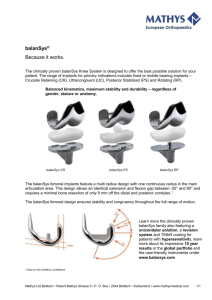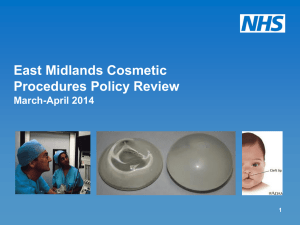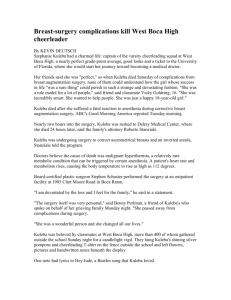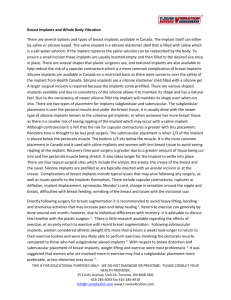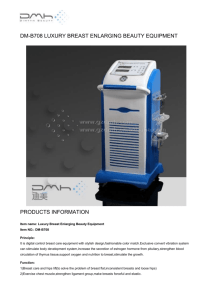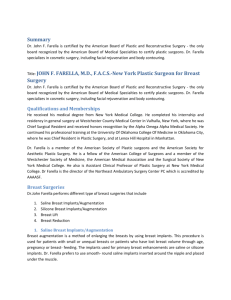Methods of Breast Augmentation
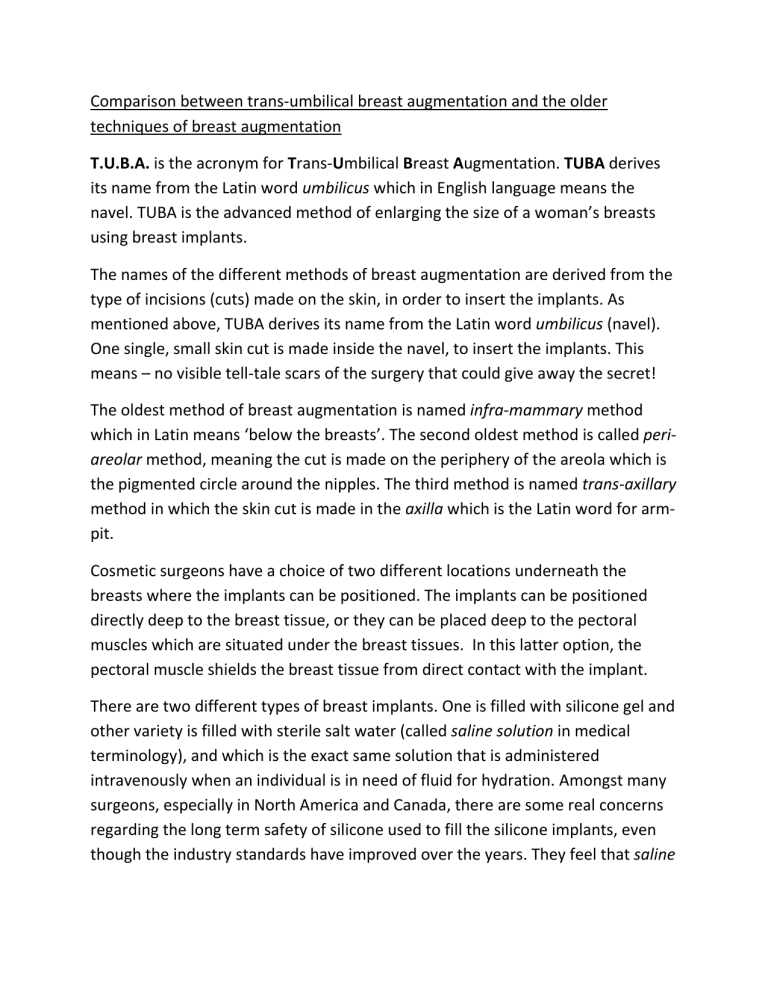
Comparison between trans-umbilical breast augmentation and the older techniques of breast augmentation
T.U.B.A. is the acronym for Trans-Umbilical Breast Augmentation. TUBA derives its name from the Latin word umbilicus which in English language means the navel. TUBA is the advanced method of enlarging the size of a woman’s breasts using breast implants.
The names of the different methods of breast augmentation are derived from the type of incisions (cuts) made on the skin, in order to insert the implants. As mentioned above, TUBA derives its name from the Latin word umbilicus (navel).
One single, small skin cut is made inside the navel, to insert the implants. This means – no visible tell-tale scars of the surgery that could give away the secret!
The oldest method of breast augmentation is named infra-mammary method which in Latin means ‘below the breasts’. The second oldest method is called peri-
areolar method, meaning the cut is made on the periphery of the areola which is the pigmented circle around the nipples. The third method is named trans-axillary method in which the skin cut is made in the axilla which is the Latin word for armpit.
Cosmetic surgeons have a choice of two different locations underneath the breasts where the implants can be positioned. The implants can be positioned directly deep to the breast tissue, or they can be placed deep to the pectoral muscles which are situated under the breast tissues. In this latter option, the pectoral muscle shields the breast tissue from direct contact with the implant.
There are two different types of breast implants. One is filled with silicone gel and other variety is filled with sterile salt water (called saline solution in medical terminology), and which is the exact same solution that is administered intravenously when an individual is in need of fluid for hydration. Amongst many surgeons, especially in North America and Canada, there are some real concerns regarding the long term safety of silicone used to fill the silicone implants, even though the industry standards have improved over the years. They feel that saline
solution used in the saline implants is physiologically safe for the body. However the manufacturers seem to promote silicone implants, which cost more.
In most western countries such as U.S., and in South America, the surgeons prefer to place the breast implants underneath the pectoral muscles, as they believe that it gives a more natural and pleasing appearance of the breasts – the pectoral muscles provide a cover of padding so that the sharp round edges of the implants are not readily visible. Also since the implants are not in direct contact with the breast tissue, they do not interfere with mammography in the future. Those surgeons also feel that if the implants are placed right under the breast tissues, they will have a fake appearance as they are more likely to be noticed because the very discernible silhouette of the edges of the implants protruding under the skin.
However, many other surgeons prefer to place the implants directly under the breast tissue because it is a much easier method to perform and also, patients tend to complain less about post-operative discomfort.
TUBA procedure was invented and first described by the American cosmetic surgeon, Dr. Gerald Johnson of Houston, Texas, who personally trained our cosmetic surgeon, Dr. Abraham Zachariah in this procedure. Dr. Zachariah has performed over 2500 TUBA surgeries.
TUBA is an improvement over the earlier methods of breast augmentation.
However, not many surgeons have been able to master this technique and the ones who have not, tend to raise unfounded criticism.
The very first method of breast augmentation was developed in the late 1950s, also by two American surgeons, Dr. Cronin and Dr. Gerow from Texas. In this earlier method of breast augmentation, implants made out of liquid silicone were inserted through cuts made on the skin under the breast folds, the so called infra-
mammary method. It is a very simple method, which is a plus point. The down side is that the so-called “smile” scars of surgery are obviously visible under the breasts, and there is a slightly higher chance for the implants to erode the
relatively thin tissues in the skin fold below the breasts. Also, some discomfort from the support brassiere pressing on the skin cuts during the healing phase.
The old adage, “necessity is the mother of invention” is very true - In their quest to make the surgical scars not so visible , cosmetic surgeons then developed the so called “peri-areolar” technique in which the skin cuts are made on the very edge of the areola, the aim being to end up with scars that are harder to notice.
The plus point here is the reduced visibility of the surgical scars. Even though the chances are remote, there is the possibility of losing nipple sensation, with this technique. The length of the duration of surgery is slightly longer.
In their continuing endeavor to hide the surgical scars, surgeons then developed the “trans-axillary” method. Here, the surgical scars are hidden in the natural skin crease in the arm pit, which gives this method an advantage. The downside is that it is physically more demanding on the surgeon, when the implants are placed in its space deep to the pectoral muscles. Before the advent of surgical cameras and endoscopes in the field of breast cosmetic surgery, reduced visibility was a detriment in this type of breast augmentation. But now-a-days, this is a moot issue. One other negative for this type of operation is the very remote possibility of injury to the sensory nerve of the nipple that traverses the tissues of the armpit on its way to the nipple. Because of the moisture from the sweat glands in the arm pit, some patients experience minor wound infections, which even though tends to be not serious, can produce ugly scars, which beats the very purpose of this technique.
And now enters the trans-umbilical breast augmentation, the latest in the evolution of breast augmentation surgery. This method requires only one single very small cut in the navel that is almost invisible, once healing of the cut is completed, typically in about four weeks. It is the technique that takes the least amount of time to perform. Most women who choose this technique, are able to resume their full level of usual activities within a couple of weeks, or even shorter when the implants are placed right underneath the breast tissue. Because the skin cut is only a few millimeters long, only saline implants are used for this procedure.
But again, as mentioned above, many surgeons and patients feel more secure
about saline implants as compared to silicone implants. Some criticism had been raised that saline implants have a less natural feel in very skinny women, but that issue is negated with the implants placed under the pectoral muscles, which give the implants a nice padding and hence a very natural feel and also natural appearance of the breasts. Infection of the surgical incision is very rare in this method. There is hardly any blood loss with the TUBA method. Nipple sensation is preserved and ability to breast-feed is retained.
There are not many long term side effects to breast augmentation surgery. Most women who have breast implants believe that they feel better about themselves and more sensuous. The one single negative thing about breast implants is that some women tend to develop firmness of the breasts over time. This condition is called “capsular contracture”. In this condition, there is increased scar tissue build-up internally, around the implants. This condition is treatable. So far, the
TUBA method seems to have the least problems with capsular contracture.
Patients are offered all the different options and we will help them choose the option that is the right one for them.

